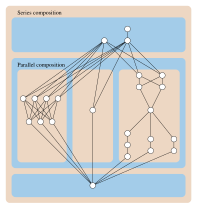Series-parallel partial order

Okay kiddo, so imagine you have a bunch of toys, and you want to put them in a specific order. The order depends on how much you like each toy and how important they are to you.
Now, let's say you have two different ways you can sort your toys. One way is called the "series" method, and the other way is called the "parallel" method.
In the series method, you line up your toys one after the other in a row. Each toy is connected to the next toy and they all have to be in a specific order. Kind of like how the letters in the alphabet have to be in a specific order (A, B, C, D...).
In the parallel method, you group your toys together and they all have to be in a specific order within their own group. However, the groups themselves can be in any order. It's like how you group your toys by type (all the cars together, all the dolls together), but the order within each group doesn't matter.
Now, when we talk about a "partial order," that means we don't have a set way to order everything. Some things are more important than others, but we don't have a specific order for all of them.
So, with series-parallel partial order, we have some toys that need to be in a specific order (the series part), and some toys that can be grouped together but the order within the group doesn't matter (the parallel part).
It's like sorting your toys based on both importance and type. The toys that are most important to you have to be in a specific order (like the series method), but the different types of toys can be grouped together in any order within their group (like the parallel method).
Now, let's say you have two different ways you can sort your toys. One way is called the "series" method, and the other way is called the "parallel" method.
In the series method, you line up your toys one after the other in a row. Each toy is connected to the next toy and they all have to be in a specific order. Kind of like how the letters in the alphabet have to be in a specific order (A, B, C, D...).
In the parallel method, you group your toys together and they all have to be in a specific order within their own group. However, the groups themselves can be in any order. It's like how you group your toys by type (all the cars together, all the dolls together), but the order within each group doesn't matter.
Now, when we talk about a "partial order," that means we don't have a set way to order everything. Some things are more important than others, but we don't have a specific order for all of them.
So, with series-parallel partial order, we have some toys that need to be in a specific order (the series part), and some toys that can be grouped together but the order within the group doesn't matter (the parallel part).
It's like sorting your toys based on both importance and type. The toys that are most important to you have to be in a specific order (like the series method), but the different types of toys can be grouped together in any order within their group (like the parallel method).
Related topics others have asked about:
